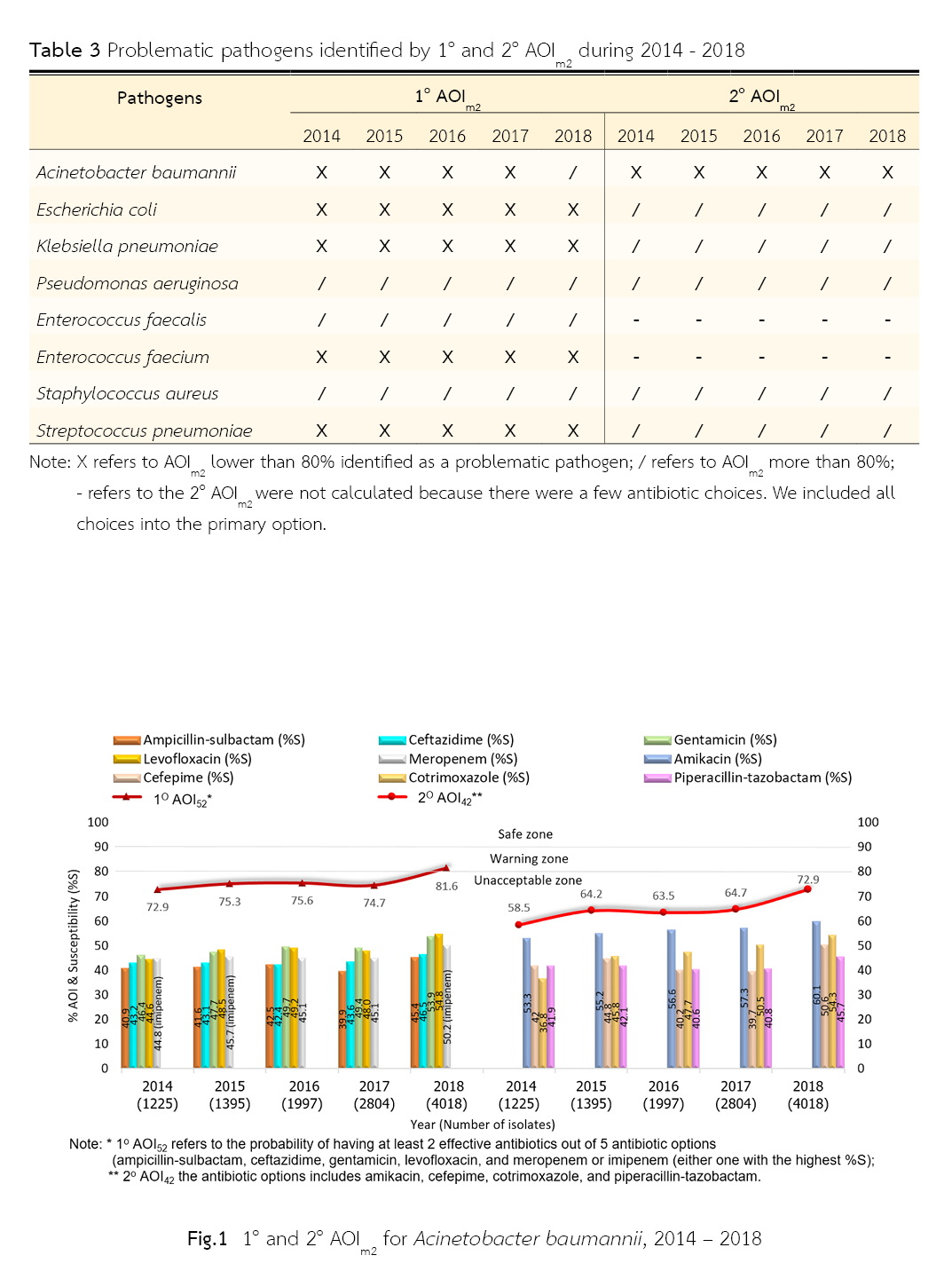Identifying Problematic Pathogens in Thailand From 2014 to 2018 Using Antibiotic Options Index
Keywords:
antibiotic options index, antimicrobial resistance, commonly found pathogens, problematic pathogen, ThailandAbstract
Background: The antimicrobial resistance status of one pathogen is always involved with many antibiotics. Some antibiotics may have decreased susceptibility while increased susceptibility in others, making it difficult to quantify the overview of resistance situation. The antibiotic options index (AOI) can present this status as the probability of effective antibiotic treatment.
Objectives: This study aimed to identify problematic pathogens using the antibiotic options index among 8 commonly found pathogens isolated from blood specimens in Thailand from 2014 to 2018.
Materials and Methods: The antibiotic susceptibilities of the 8 commonly found pathogens isolated from blood specimens were collected from the national antibiogram 2014 - 2018 published by the NARST official website. The antibiotic options index was generated and presented as AOIm2, which refers to the probability of having at least 2 effective antibiotics out of m antibiotic options. The AOI of the primary (1o AOIm2) or secondary antibiotic options (2o AOIm2) lower than 80% has been defined as a problematic pathogen.
Results: During 2014 – 2017, 5 problematic pathogens had 1o AOIm2 below 80% were Acinetobacter baumannii, Escherichia coli, Klebsiella pneumoniae, Enterococcus faecium, and Streptococcus pneumoniae; while in 2018, it had the same problematic pathogens as in 2014-2017 except A. baumannii. During 2014 – 2018, a problematic pathogen that had 2o AOIm2 below 80% was A. baumannii.
Conclusions: During 2014-2017 there were 5 problematic pathogens had 1o AOIm2 below 80%, whereas there were 4 pathogens in 2018.One problematic pathogen that had 2o AOIm2 below 80% was found during 2014 – 2018.
References
Kraker MEA, Wolkewitz M, Davey PG, Grundmann H. Clinical impact of antimicrobial resistance in European hospitals: Excess mortality and length of hospital stay related to methicillin-resistant Staphylococcus aureus bloodstream infections. Antimicrob Agents Chemother. 2011;55(4):1598–605.
Cosgrove SE. The relationship between antimicrobial resistance and patient outcomes: mortality, length of hospital stay, and health care costs. Clin Infect Dis. 2006;42(Suppl 2): S82-9.
Dellit TH, Owens RC, McGowan JE, Gerding DN, Weinstein RA, Burke JP, et al. Infectious Diseases Society of America and the Society for Healthcare Epidemiology of America guidelines for developing an institutional program to enhance antimicrobial stewardship. Clin Infect Dis. 2007;44(2):159–77.
Timsit JF, Harbarth S, Carlet J. De-escalation as a potential way of reducing antibiotic use and antimicrobial resistance in ICU. Intensive Care Med. 2014;40:1580–2.
Munoz-Price LS, Quinn JP. Deconstructing the infection control bundles for the containment of carbapenem-resistant Enterobacteriaceae. Curr Opin Infect Dis. 2013;26(4):378–87.
Tacconelli E, Cataldo MA, Dancer SJ, Angelis GD, Falcone M, Frank U, et al. ESCMID guidelines for the management of the infection control measures to reduce transmission of multidrug-resistant Gram-negative bacteria in hospitalized patients. Clin Microbiol Infect. 2014;20 (Suppl 1):1–55.
Doshi P. Speeding new antibiotics to market: A fake fix? BMJ. 2015;350:h1453.
Laxminarayan R, Duse A, Wattal C, Zaidi AKM, Wertheim HFL, Sumpradit N, et al. Antibiotic resistance—the need for global solutions. Lancet Infect Dis. 2013;13(12):1057–98.
Centers for Disease Control and Prevention. US CDC report on antibiotic resistance threats in the United States, 2013 [Internet]. [cited 2020 January 30]. Available from: https://www.cdc.gov/drugresistance/threat-report-2013/pdf/ar-threats-2013-508.pdf
Manomayitthikan T, Borlace GN, Kessomboon N. Development of an antibiotic options index for antibiotic resistance monitoring. Southeast Asian J Trop Med Public Health. 2016;47(6):1288–97.
National Antimicrobial Resistance Surveillance Center of Thailand. Antibiogram [Internet]. [cited 2020 February 10]. Available from: http://narst.dmsc.moph.go.th/antibiograms.html
Clinical and laboratory standards institute. M100 Performance standards for antimicrobial susceptibility testing [Internet]. [cited 2020 January 15]. Available from: https://file.qums.ac.ir/repository/mmrc/CLSI-2018-M100-S28.pdf
National Antimicrobial Resistance Surveillance Center of Thailand. Antibiogram [Internet]. [cited 2020 February 10]. Available from: http://narst.dmsc.moph.go.th/antibiograms/anti2000.pdf
Malathum K. Antibiotic resistance crisis and antibiotic use in Thailand. The report of the situation of drug system 2010:11-15 (in Thai). Available from: http://www.thaidrugwatch.org/download/otherprint/2010_drug_system_report.pdf
Cao J, Song W, Gu B, Mei Y, Tang J, Meng L, et al. Correlation between carbapenem consumption and antimicrobial resistance rates of Acinetobacter baumannii in a university-affiliated hospital in China. J Clin Pharmacol. 2013;53:96-102.
Yang P, Chen Y, Jiang S, Shen P, Lu X, Xiao Y, et al. Association between antibiotic consumption and the rate of carbapenem-resistant Gram-negative bacteria from China based on 153 tertiary hospitals data in 2014. Antimicrob Resist Infect Control. 2018;7:137.

Downloads
Published
How to Cite
Issue
Section
License
Copyright (c) 2022 Association of Hospital Pharmacy (Thailand)

This work is licensed under a Creative Commons Attribution-NonCommercial-NoDerivatives 4.0 International License.
ข้อความภายในบทความที่ตีพิมพ์ในวารสารเภสัชกรรมโรงพยาบาลทั้งหมด รวมถึงรูปภาพประกอบ ตาราง เป็นลิขสิทธิ์ของสมาคมเภสัชกรรมโรงพยาบาล (ประเทศไทย) การนำเนื้อหา ข้อความหรือข้อคิดเห็น รูปภาพ ตาราง ของบทความไปจัดพิมพ์เผยแพร่ในรูปแบบต่าง ๆ เพื่อใช้ประโยชน์ในเชิงพาณิชย์ ต้องได้รับอนุญาตจากกองบรรณาธิการวารสาร (สมาคมเภสัชกรรมโรงพยาบาล (ประเทศไทย)) อย่างเป็นลายลักษณ์อักษร
สมาคมเภสัชกรรมโรงพยาบาล (ประเทศไทย) อนุญาตให้สามารถนำไฟล์บทความไปใช้ประโยชน์และเผยแพร่ต่อได้ โดยอยู่ภายใต้เงื่อนไขสัญญาอนุญาตครีเอทีฟคอมมอน (Creative Commons License: CC) โดย ต้องแสดงที่มาจากวารสาร – ไม่ใช้เพื่อการค้า – ห้ามแก้ไขดัดแปลง, Attribution-NonCommercial-NoDerivatives 4.0 International (CC BY-NC-ND 4.0)
ข้อความที่ปรากฏในบทความในวารสารเป็นความคิดเห็นส่วนตัวของผู้เขียนแต่ละท่านไม่เกี่ยวข้องกับสมาคมเภสัชกรรมโรงพยาบาล (ประเทศไทย) และบุคลากรในสมาคมฯ แต่อย่างใด ความรับผิดชอบองค์ประกอบทั้งหมดของบทความแต่ละเรื่องเป็นของผู้เขียนแต่ละท่าน หากมีความผิดพลาดใด ๆ ผู้เขียนแต่ละท่านจะรับผิดชอบบทความของตนเอง ตลอดจนความรับผิดชอบด้านเนื้อหาและการตรวจร่างบทความเป็นของผู้เขียน ไม่เกี่ยวข้องกับกองบรรณาธิการ


.png)

